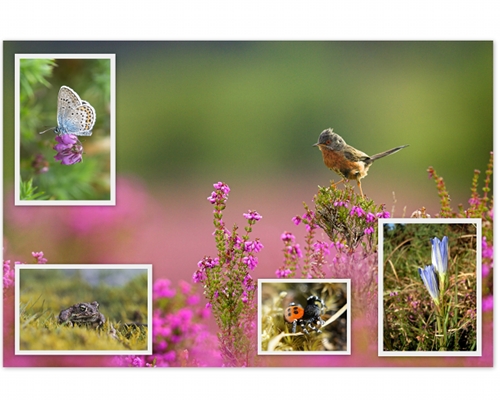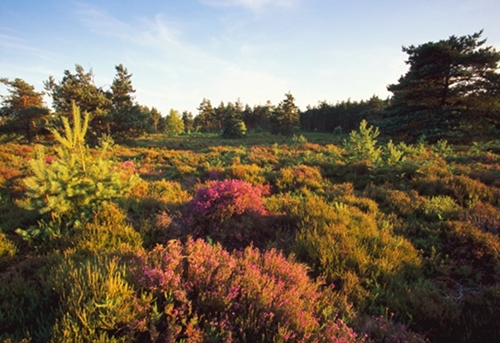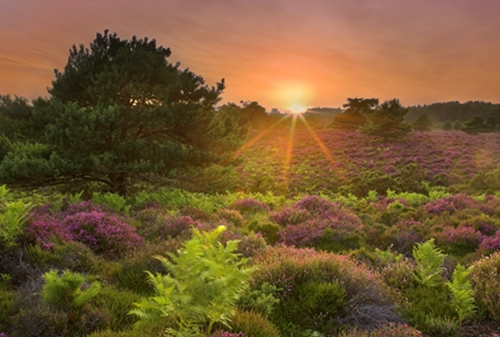The RSPB is driven by the belief that we all have a responsibility to protect wildlife and the environment. Our vision is a world rich in wildlife — there for everyone to enjoy.
We have campaigned for almost 30 years on the full spectrum of forestry issues, from policy and legislation through to practical forestry management – Our first major public campaign on forestry was in 1982. We work actively to conserve wildlife of woodland and open habitats such as heathland. We are also practitioners. We manage over 8,800ha of woodland and 2,400ha of heathland. We are actively creating native woodland on twice as much area on our reserves than we are clearing plantations to restore (internationally) important open habitats.
The RSPB is also supporting others to re-create heathland, for example we are working in partnership with the Forestry Commission and others to restore heathland on their estate at Dunwich Forest, Suffolk .
Put simply, we don’t think the decision is heathland or woodland, we want more, better managed and better connected areas of both.
Why do we care about lowland heathland?
Lowland heathland is an incredibly rare habitat supporting a breathtaking array of threatened wildlife:
– Since 1800, about 80% has been destroyed to make way for conifer plantations, housing development and agriculture – that is equivalent to losing an area of habitat the size of greater London.
– It now only covers around 0.3% of the UK’s land area. Yet, despite this being such a small area it is a fifth of the entire world total – this is a mightily rare habitat!
– Heathland supports an extraordinary number of our most threatened wildlife, for example heath tiger beetle, marsh gentian, ladybird spider, Dartford warbler, smooth snake and natterjack toad to name a few.
– Under the Rio Convention (that international cornerstone for saving wildlife) the UK has committed to conserve this amazing habitat, because of its unique importance to nature.
– It has a rich cultural history and links with humankind dating back over 6000 years, and is a source of inspiration to countless artists, musicians and writers, including Wordsworth and Shakespeare.
– It brings in millions of pounds to local economies as an integral part of the habitat network drawing tourists to places like Dorset, Suffolk and Hampshire.
Why restore more heathland?
Losing 80% of any habitat is a big deal, and this has left many of the remnant areas as small and isolated patches. This places these sites and the wildlife that depend on them at greater risk from threats such as fires, encroachment and extinction. It is no surprise that heathland wildlife is some of the rarest in the UK. Wildlife needs space if it is to adapt and respond to threats. The report of Professor Sir John Lawton and his distinguished group of experts could easily have had lowland heathland in mind when it called for more, bigger, better managed and better connected areas.
In addition to the obvious benefits of more robust habitats, it also has positive effects on management costs. Larger habitats are easier and cheaper to manage due to economies of scale.

A few of the many rare and threatened species dependent on the future of heathland; the marsh gentian, natterjack toad, silver-studded blue butterfly, Dartford warbler and ladybird spider (photo credit Ian Hughes).
Where can heathland be re-created?
In contrast to woodland creation, only a few places have the right mix of unique conditions to return damaged heathland back to life. These are former heaths that were either lost to plantation forestry, converted to agriculture, mineral workings or have reverted to early successional woodland due to lack of management. Out of these, restoration from conifer plantations tends to be the most practical because it generally preserves the soil conditions the best. However, the clock is ticking and the longer these unique sites are used to grow conifer crops, the further the soil conditions degrade and eventually the ability to restore heathland on these sites will be lost to future generations forever. We are never going to get back to the level of heathland we once had in the UK, but there is still time to restore some of it, and give heathland wildlife a more stable future.
The importance of the Public Forest Estate:
The Forestry Commission came into existence in 1919 when it was charged with increasing timber production to help support the war effort. Vast swathes of lowland heathland, ancient woodland and other habitats were planted with fast growing plantations. The Forestry Commission has come a long way since then, and is making important progress in restoring heathland in places like Dorset, the Brecks and Suffolk Sandlings but most of their former heathland estate still has no plans for restoration.
The Public Forest estate has more former heathland under conifer plantation than anyone else. This is why the public forest estate is well placed to lead the way in habitat restoration, because it can create the landscape scale areas of heath and ancient woodland that wildlife needs, whilst also making its existing heathland habitats more economically viable to manage. This does not mean chopping down places like Thetford Forest, but rather making the small areas of existing heathland bigger to form a more robust part of a varied habitat network.
Interestingly, whilst only 14% of the Public Forest estate is currently open habitat, studies by the plant conservation charity Plantlife indicate that 77% of all the rare and threatened flowering plants found within the Public Forest Estate are actually species that depend on open habitats, such as heathland.
When given the right tools, Forestry Commission can be an excellent land manager, but this requires a clearer remit and taxpayer support, so that the business of making money is not conflicting with the business of providing a public service.
How much woodland is being lost to heathland re-creation?
The area of woodland in England is increasing approximately 5 times faster than the area of heathland being restored each year. However, we think the rate of both is still too slow. There is much misinformation about heathland re-creation. Some commentators suggest that it involves the full scale destruction of woodland. In fact, this is confusing the debate because in most cases it involves the clearance of conifer plantations, established on heathland mainly as a timber crop. Once they are felled for their timber, this is the point at which the public or private owner/manager has to decide to either allow the heathland to return or plant again with more conifers. No-one would dream of planting existing heathland with conifer crops these days, so it seems a bit strange that the few areas we have left for its re-creation are continually being restocked and degraded,
This is about ensuring the right tree in the right place, so that woodlands and heaths can both find their place in a countryside consisting of a wide variety of habitats, fit for future generations to enjoy and for wildlife to thrive. Trees can form an important component of heathlands and vice versa, and in reality most heathland restoration proposals generally maintain at least 50% of trees on a site level for landscape or other reasons.
Local participation in decision making
We believe local involvement in heathland re-creation proposals is essential. The RSPB has advocated that this be built into the Government’s policy on open habitat restoration. Any change in the landscape will engender both positive and negative reactions, and plans should address both sides. The Government’s policy on open habitats sets out the importance of involving the full range of local stakeholders in decision making.
Go and see it for yourself:
Heathlands are sometimes unfairly characterised as gloomy, barren and dead places. Well-managed heathland at the height of summer is the opposite of all of these things. They are almost gaudily colourful, a riot of purple heather and pink spikes of ling, often bounded in by gorse, with its lemon-coloured flowers and sweet coconut fragrance. The clacking call of the stonechat beats time to the fluid song of the woodlark, while bees and butterflies dance among the blossoms.
But don’t take our word for it, go and experience it for yourself, and I can think of no better place than the Forestry Commission managed New Forest, which shows what can be achieved when woods and heathlands are both seen as equally valued components of the landscape.
“He who has once seen a Ghost” said Cardinal Newman, “is never again as though he had not seen a ghost”, and he who has once vibrated with the thrill of the heathland is never again quite the same… those who have once come under its spell are ever after its slaves”
These words were penned by W G Clarke, writing about the heaths and grasslands of the Brecks in the heart of East Anglia. Clarke was probably Breckland’s greatest authority, and certainly its greatest champion: indeed it was he who coined the term ‘Breckland’ in 1895, which this area is still known to this day (Clarke 1925).
Read more articles on Heathland Restoration and the issues surrounding it’s recreation.





























Having grown up in Suffolk and being very familiar with all the habitats the county has to offer, I find it strange that there is so much resistance to lowland heathland restoration. Heathland is full of native important biodiversity, it is an internationally threatened habitat (of which the UK holds 20% of the global lowland heathland) and areas that once were heathland are currently smothered by non-native ugly conifer plantations!
It is great to see that the RSPB are valuing both Heathland and native woodland (I stress the word native), and putting in the effort to ensure we all have the opportunity to enjoy these habitats and the wildlife they support, now and into the future.
Restoration of any habitat will not occur overnight, and the fact that newly felled conifer plantation being restored into heathland is not pleasing on the eye is a small price to pay for the long term prospects of healthy heathland for years to come.
It is pleasing to see the RSPB restoring this habitat and shouldering some of the responsibility of ensuring that future generations also gain the benefits and pleasure of this special Suffolk environment!